Everyone needs an escape sometimes. Camping in an RV is a great way to kick back and recharge. But sometimes, crowded RV parks can leave us feeling anything but relaxed. If you want to connect with nature and enjoy the surrounding land, there’s no better way than camping off the grid, better known as boondocking. We’ve been enjoying Class A RV boondocking for nearly two decades! Whether you’re a seasoned boondocker or you’ve never tried it before, we’ve got some tips for you, so read on.
What is Boondocking?
Boondocking is a simple way to camp for free. What? Free camping?! Sounds too good to be true, right? It isn’t, but there is a bit of a catch.
When we’re boondocking, we have no hookups: which means no city water, no shore power, and no sewer connection. But even in a large Class A RV, boondocking is our favorite way to camp by far. How can this be?! Well, even without hookups, there are many ways to live a life of luxury in the wild.
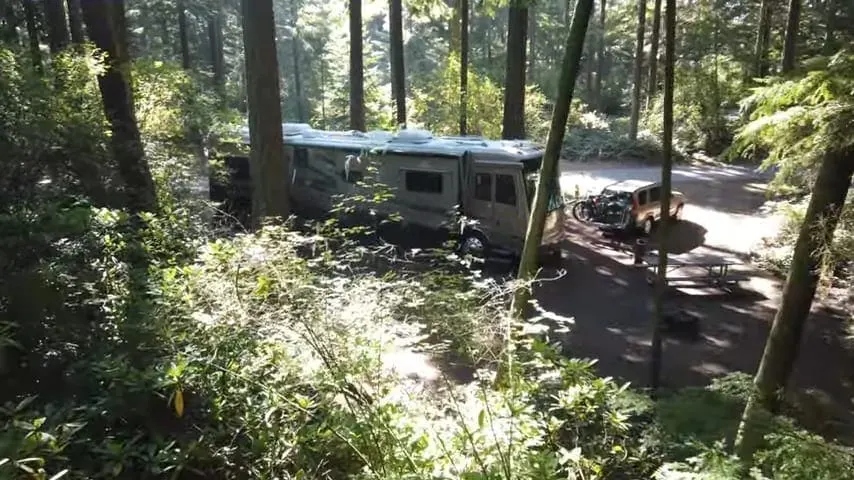
Boondocking in nature is our favorite way to camp!
In truth, there’s nothing more luxurious than nature. The sun shining, the leaves rustling in the breeze, the stars shining down through a clear sky as you sit around a crackling campfire, with much of civilization far away in both miles and mind.
But we still want to be able to take a shower after enjoying the vistas we experienced as we hiked. And we still want to cook dinner, make our morning coffee, and stay connected to news (well, maybe not news) and loved ones (definitely loved ones). How do we do all of this without hookups?!
Let’s have a look at what you need to do to have all of these amenities while living in the lap of nature’s luxury for a while.
Essential Items for Class A RV Boondocking
To prepare for a successful Class A RV boondocking experience, you’ll need to make sure your rig is properly-suited in the following ways:
Power Supply
The whole point of having a Class A RV is to feel comfortably “at home” in your rig, and a proper supply of power goes a long way in achieving that degree of comfort.
There are two main options for powering your rig without electric hookups.
The first option is to run your generator. Most Class A RVs include a generator. It’s a straightforward way to get power that probably won’t include any additional setup work. Simply fire up the generator, and you have power as usual. The major downside to a generator is the noise. They can be pretty loud when they’re running. You also need to make sure you don’t run out of fuel.
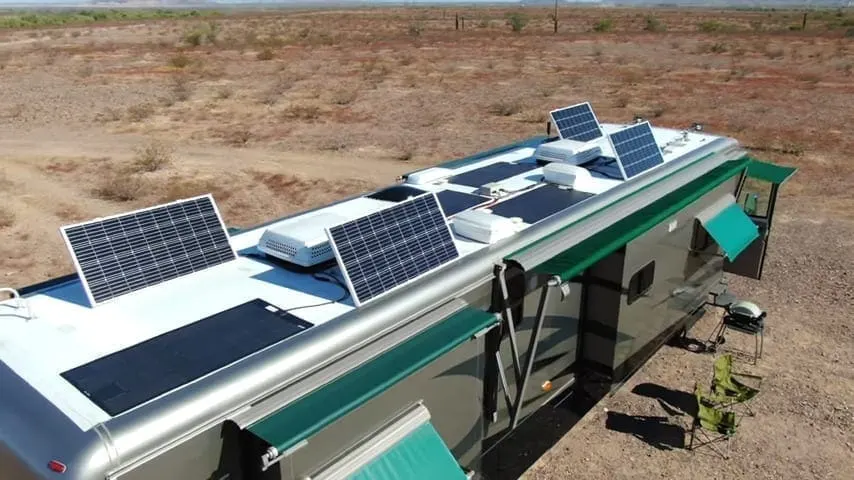
Solar panels allow us to boondock while harnessing the power of the sun. That’s 1,300 watts up there!
If you want to boondock in your Class A for longer (and more quietly), the better option is solar power. Solar panels are a boondocker’s best friend. As long as there’s sun, you won’t run out of power. This allows you to stay in one place for longer. Still, it’s nice to have a generator as a backup in case you run into some cloudy days or you’ve chosen to park among majestic (but shady) trees!
A solar power setup requires some work and expense at the outset. But the benefits are unquestionably worthwhile, especially if you plan on Class A RV boondocking regularly.
Wastewater Management
Dealing with wastewater is part of RVing. When you’re boondocking, this job becomes a little trickier. Having no hookups means you won’t be able to dump your tanks as frequently. To make sure you can correctly manage your wastewater, it is good to have large grey and black tanks, another benefit of a large Class A rig.
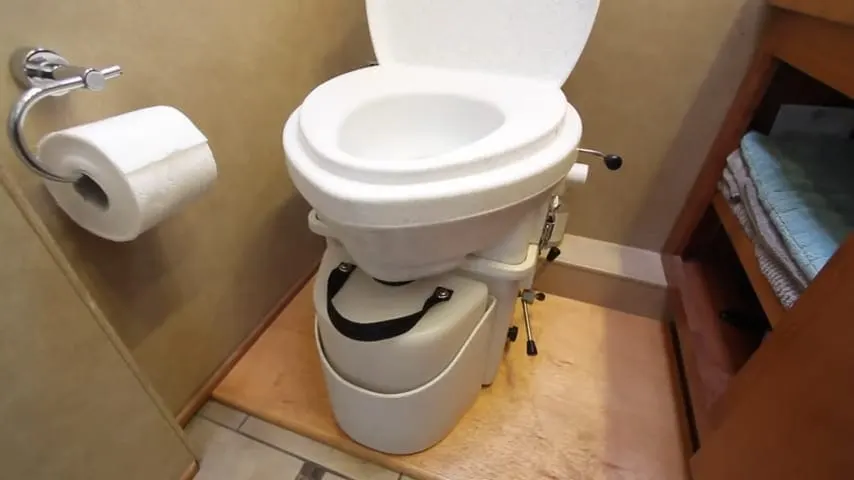
A composting toilet saves water and can leave the black water tank free for more grey water.
The larger your tanks, the more they can hold, and the longer you can stay off the grid.
Another way to conserve wastewater space is to consider a composting toilet. Depending on the way your wastewater holding tanks are arranged (side by side, or stacked), this modification can even allow you to use your black tank for holding extra grey water.
We’ve not chosen to make this modification yet, but we’ve been thinking about it for years! We do have friends who have switched to a composting toilet, and they’re very happy with the modification.
Garbage Management
When your garbage can fills up, you can’t just stroll down to the nearest RV park dumpster and toss it out. You need a way to manage your trash for the duration of your trip – a way that won’t create odors in your RV or attract bugs and critters, (which is also why you can’t expect to store your trash outside).
If you have the storage space, we recommend having a couple of large, airtight totes in which to store your trash when Class A RV boondocking. You can store these in your RV’s basement just as you might in a home garage, or in your towed car. You can also keep an additional tote for recycling.
To conserve space, crush things like cans and flatten boxes before throwing them in the recycling tote. When you get home from your trip, you can dispose of your trash & recycling in the normal manner, or toss them in the dumpster during a stay at the next full hook-up RV park.
If you’re a full-timer, on the road for a longer stretch of time, you may want to stay at an RV park periodically as we do. This allows you to dump your tanks, toss your trash, fill your freshwater tank, and even do laundry, all in the same visit.
Plenty of Fresh Water
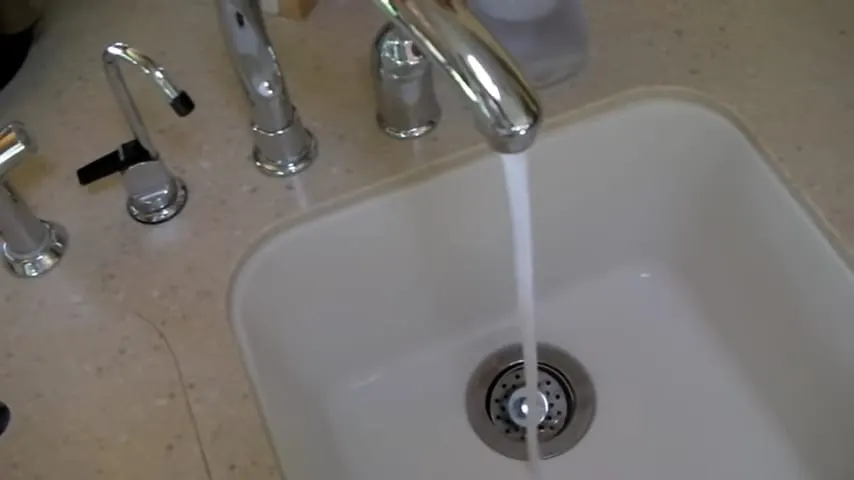
Conserving water while RV boondocking increases the time we can stay out in nature!
When preparing to boondock it’s essential to make sure you have enough fresh water to meet all your needs. Fill your fresh water tank before hitting the road or, better yet, at a location near your chosen boondocking location. Bring extra water for drinking and cooking if necessary, or be sure to check the status of your water filters if you have them.
Having a good supply of fresh water is a must for boondocking, and this is another area where the size of a Class A RV is helpful. A larger rig equals larger tanks. You need fresh water not just for drinking and cooking but also for doing dishes, showering, and flushing the toilet (unless you have a composting toilet, as mentioned above).
It’s also important to conserve fresh water while boondocking. There are a variety of simple ways to do this. Let’s take a look at a few:
One of the simplest ways to conserve water is not to shower every day. Premoistened wipes or a cloth with some soap and warm water are sufficiently cleansing most of the time if you don’t have enough water for daily showers. Learning how to take showers that conserve water is also very helpful. (Search the term “navy shower” for instructions)!
Use your napkin to wipe plates of food residue before washing them, then be mindful of your water usage when washing your dishes. Alternatively, you can use disposable/compostable plates, bowls, and cups while boondocking.
Plenty of Food
When you plan your boondocking adventure, consider how long you’ll be gone and how much food you’ll need for that duration of time. When in doubt, err on the side of bringing more food than you project you’ll need, rather than less. It’s always good to have extra non-perishables on board in case you start running low on fresh food. And before heading out on your RV boondocking trip, you may want to do some additional food prep (washing lettuce/vegetables, doing some extra cooking, etc) so that you can conserve water while you’re out there.
A Great Class A RV Boondocking Spot
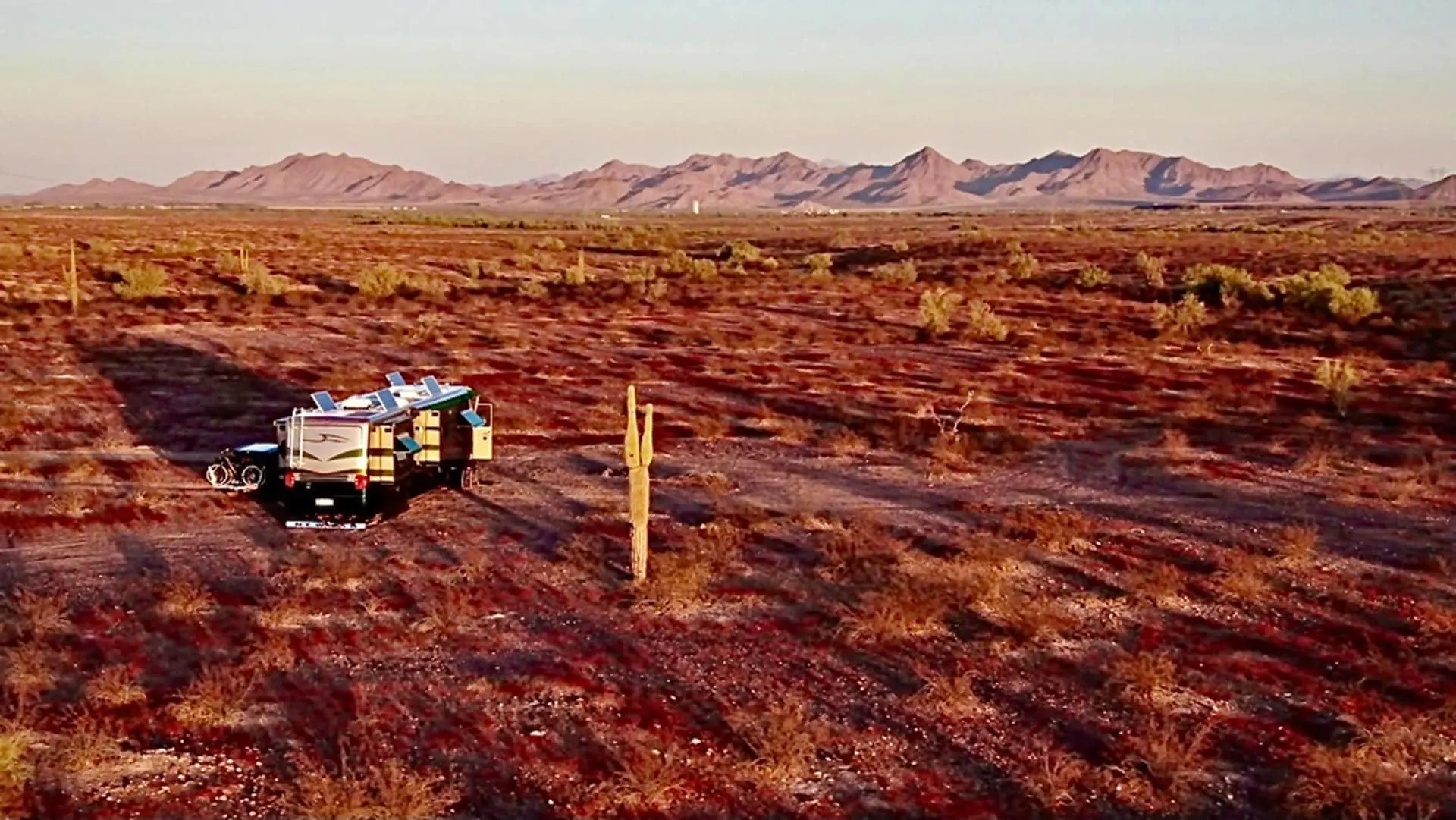
There are so many beautiful places to boondock all over the world. There’s nothing like it!
Finding a suitable spot is a little more difficult for Class A RV boondocking. Narrow roads, overhanging branches, small campsites, and even ground that won’t support our weight are all factors in whether or not we can stay in a particular location.
Many people envision boondocking in a smaller trailer or a van. But there are lots of glorious spots for boondocking in your Class A as well! We know this because we’ve spent many years mostly boondocking in both our current diesel pusher, and our first one as well. It may take a little more work to find a great spot, but they’re out there!
Boondocking With a Class A RV
If you’re wondering where on Earth you would park a large Class A RV for a stretch of boondocking, you can trust us when we tell you that there are plenty of wide-open spaces to park your rig and enjoy the Class A RV boondocking lifestyle.
For example, BLM (Bureau of Land Management) lands are a great place for boondocking in any rig, but these lands offer immensely spacious locations for Class A rigs to settle for a while. BLM camping rules limit your stay in one location to 14 days, and then you’ll need to move on to another stretch of land. Two weeks is getting close to the limit we’re comfortable with before we want to hook up at a park to tend to our tanks and other errands, however, so this works perfectly for us.
We’re about to let you in on the secret to finding amazing boondocking spots for Class A rigs! Ready? Read on!
Tips for Finding a Great Class A RV Boondocking Spot
Now, more than ever before, there are a ton of great resources available for finding that perfect spot to boondock.
Use These Apps and Websites
Technology is a beautiful thing. The Internet and many smartphone apps offer you a real-life sneak peek at potential boondocking sites, allowing you to find the best ones for you. Not all websites and apps are created equal, though. Here are our top apps and websites for finding amazing Class A RV boondocking sites:
The Dyrt, Campendium, AllStays, Freecampsites.net, and the Boondocking app. Any of these sites will offer you a plethora of options for parking and boondocking in your Class A rig.
While we’re talking about finding places to camp, The Dyrt PRO offers special features to make planning even easier:
- Plan camping road trips with Trip Planner
- Find free dispersed camping with Map Layers
- Use The Dyrt app anywhere with Offline Access
- Unlock camping and gear discounts
While The Dyrt PRO is a premium service, we’ve arranged for RVgeeks viewers to get a FREE 30-DAY TRIAL (normally it’s only 7 days)!
Use the "Go To The Deal" button to access the website, then click the "Redeem Your Gift" button found there to start your FREE 30-DAY TRIAL (a credit card is required, but you can cancel at any...Show More
Use the "Go To The Deal" button to access the website, then click the "Redeem Your Gift" button found there to start your FREE 30-DAY TRIAL (a credit card is required, but you can cancel at any time).
NOTE: the discount code field should fill in automatically. If it doesn't, click "I have a discount code" and enter code RVGEEKS to start your 30-day free trial.
Show LessRead Reviews
Be sure to read reviews! These are written by RVers for RVers, and they’ll give you an honest perspective on what you can expect at any given location, based on their own experiences. They’ll let you know what driving into the area is like with the size and clearance of a Class A rig in mind as well as important notes such as whether you might have difficulty turning around.
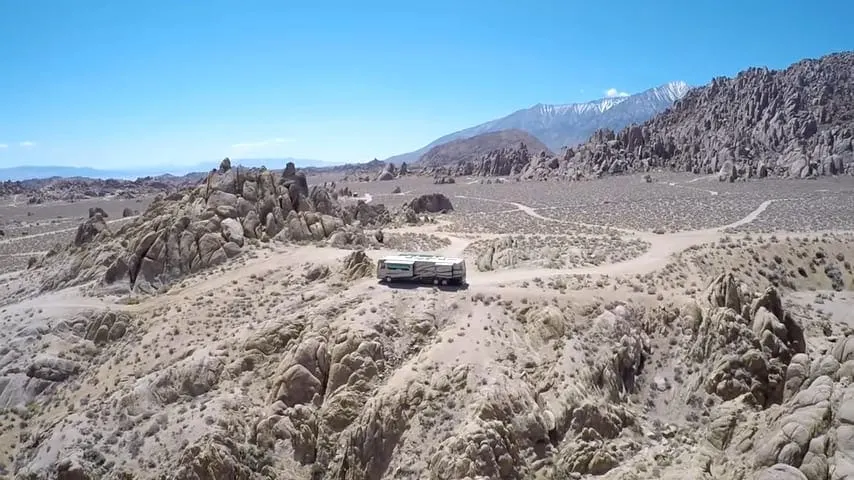
Be sure to do your research, read reviews, and check Google Satellite views before entering a boondocking location, especially with a large Class A RV.
Online reviews also often show pictures, discuss safety, and even include cell coverage in the area. Paying attention to these reviews will help to make your boondocking experience memorable… in a good way!
Use Google Satellite View to Scope Spots
If you’ve researched potential boondocking sites for your Class A RV but still have some reservations, use Google Satellite View. This feature of Google Maps will let you zoom in to determine if a site looks big enough for your rig. Just as important, you’ll be able to actually view the route in and out.
We always recommend scoping out a campsite on Google Satellite before heading to any potential location.
If Possible, Scout it Out
Scouting isn’t always possible, but when it is, we highly recommend it. If you can drive your car to a particular location in advance, you can check out the road conditions. If it isn’t too far off the main highway, you could even have a traveling companion run ahead to check things out as you’re arriving with your RV.
You never want to get stuck down a forest road or on public lands without being able to turn around. That’s why planning, reading reviews, using Google Satellite View, and scouting things out is so necessary. This is true for all boondockers but is especially true when you’re boondocking in a large Class A motorhome.
Conclusion
The key to successful, enjoyable Class A RV boondocking planning. Before you even hit the road, make sure you properly set up your RV for off-grid life. Then check reviews and scout out sites in advance. Many RVers are understandably intimidated by the thought of boondocking. But once you’ve tried it, you’ll surely want to boondock more and more!
Geek Out with Us Every Week
Join our newsletter to learn about all things RV-related. Every week we offer free tips, tricks, product reviews, and more to our online community of RVers. Whether this is your first time on the road or you’re a seasoned expert, we’d love for you to geek out with us!



Eileen Brown
Tuesday 30th of January 2024
I’m completely comfortable with scouting out Boondocking sites using many of the tools you mentioned. Also comfortable unhooking our toad and scouting ahead. But what we are not comfortable with is being able to tell whether the ground will support our 40,000 pound rig. As you guys are as heavy or heavier than that, how do you gauge the stability of the ground, particularly vis-à-vis weather that might be one to two weeks out?
TheRVgeeks
Wednesday 31st of January 2024
Hi Eileen! Great to hear that you're a boondocking fan, like we are. So... this is a bit of a difficult question, for a few reasons. First, our Mountain Aire clocked in fully loaded at about 39,000 lbs, very close to yours. Second, in case you hadn't seen, we did indeed get stuck while boondocking (ONCE in over 20 years)! Here's a link to the video showing us getting towed out: https://youtu.be/kLdJbDwb3OA
The main things we look for in taking a big rig off road is signs of traffic. If the route to a prospective campsite, and the campsite itself, aren't well-worn and clearly used by lots of other RVers, it's a no-go. We know that this means we can't be trailblazers in a big rig, but that is indeed one of the trade-offs in going for the comforts of a larger RV.
The other VERY important thing we look for when scoping the route in our toad is tracks in the sand/dirt. There's big difference between signs of traffic, and ruts. If we're driving in to scope the route and potential campsite in our Honda, and we see that WE are making visible tracks (in other words, our tires are sinking into loose sand or dirt), we don't go. The entire route should support the weight of the Honda with no, or very little, indentations from our car's tires.
All that said, there is some risk no matter what. We're so eager to get off-road that we're willing to take some risk, but we know it's possible to get stuck. The way we got fooled into thinking we could camp in the spot where we got stuck in the video above was because our friend Nikki Wynn had already driven their gas rig into the spot, and we were eager to camp with her. What we should have noticed it that their lighter rig had already compressed the soil more than we should have been comfortable with. After that experience, we re-calibrated our limits. We'd camped SO many times in the Quartzsite are that we lulled ourselves into a false sense of security because the landscape in South Joshua looked so similar to Quartzsite. If only we'd been more suspicious, we've have noticed than our car left indentations in the soil at the campsite, making it clearly unable to support the RV.
So looking for trafficked routes and campsites, but ones that don't allow the car to sink in or leave tracks, is the way we've avoided getting stuck again after that learning experience. And we still go way off road in new places, but with a newfound sense of caution... including how far off-road we are in case we need a tow truck again! Even when we first start driving the RV toward the site after scoping in the car, we still watch the mirrors carefully to look for signs of sinking in / leaving tracks in the motorhome. If we're leaving anything more than the shallowest tracks, we abort. Lastly, we avoid camping off-road when more than a sprinkle rain is predicted. That's pretty easy for us since we spend so much time in the desert SW in the winter.
Hope this helps. Safe travels and happy camping.
Tess
Wednesday 7th of June 2023
How long do you need to run your generator (Onan 8000) for the house batteries to charge? Once they're charged, how long will those last? I have a 2023 Fleetwood Discovery 38N.There are 4 6v house batteries.
TheRVgeeks
Thursday 8th of June 2023
Hi Tess... there's no one-size-fits-all answer to those questions. Re-charging the batteries using the generator depends on how large the battery bank is (not all 6V house batteries have the same capacity in Amp-hours... some are larger than others), how depleted it is, and how big your RV's battery charger is (i.e. how many amps can it put out at maximum charging?).
If you've got a 400Ah battery bank that's 50% depleted, that means you have 200Ah of energy to return to the batteries. If you have a 50A charger, that will take at LEAST 4 hours (200 ÷ 50)... but a 100A charger could do it in 2+ hours (200 ÷ 100 = 2)... though, in each case, it will actually be MORE than just the Amp-hours to be replaced divided by the Amp output of the charger, since a 3-stage charger doesn't continue putting out full output the whole time, to avoid damaging the batteries.
Same issue applies to how long those batteries will last you once you do recharge them completely. Factors like how old/healthy the batteries are and how much power you need to use each day are different for every RV and RVer. Do you have a standard RV absorption fridge? Or a residential (120V AC) fridge that requires the inverter to be on 100% of the time? Do you work all day, using power to keep your laptop(s) charged and your internet connectio(s) powered up? Or do you spend all day away, come back and hang outside by the campfire, and run just a few lights and maybe the vent fan for a couple of hours before going to bed?
The best thing you could probably do to help determine your typical usage, so you can plan how long your battery bank will last you between recharging, is to install (or have installed) a Battery Monitor Kit. This will allow you to (1) monitor your usage and (2) know, with greater precision, your batteries' state of charge (SOC) percentage at any given moment.
Richard Hubert
Wednesday 3rd of March 2021
Having your rig well equipped for boondocking not only enables one to stay in many very remote places for days & weeks - but it is also important to enable one to stay in many other places. This is because many spots where one can overnight - or longer - also offer NO hookups.. We have found that many National Forest CGs (and there are many - all over!) may have well prepared campsites - but most with no hookups - at all. We have also stayed at many National Park CGs where most sites offer no hookups (such as Acadia's Seawall CG, Crater Lake South CG, or Grand Tetons Gros Ventre CG). While they do often offer trash dumpsters and usually a fresh water spigot, to really enjoy staying at these locations for any period of time still requires good boondocking capabilities.
Staying at most Boondockers Welcome, Harvest Hosts, rest stops, and big store parking lots (like Walmart) can be convenient - but most offer no hookups at all either. So living in a rig which is better configured for dry camping opens up so many possibilities of where one can stay. Even helps you in most moochdocking situations and driveway surfing spots.
We are often amazed at the number of RVers we meet who believe that they can only stay at RV Parks - because they feel they need to be fully hooked up all the time. The reality is just the opposite. To us most of the point in living in an RV is it's ability to enable us to live off-grid so much of the time. Why else are most RVs built with propane appliances, 2 electrical systems, inverters, water tanks, etc - if not to enable off-grid stays?
Finally - a word about generator usage. You are certainly correct that generator noise can be a problem boondocking anywhere. But in our experience there can be other dangers - such as CO. Just over a year ago when staying on Quartzsite BLM land both of our CO detectors suddenly alarmed us to the presence of CO in our rig. We were not even running our generator - but our neighbor was. And he was not even parked that close to us. But it was a quiet early evening with no wind, and apparently his generator was pumping out CO which drifted over into our rig through our open windows. Just something else to be aware of. And keep your generator tuned-up and serviced to help avoid CO generation.
Pat Parker
Wednesday 3rd of March 2021
Great information as always
TheRVgeeks
Friday 5th of March 2021
Thanks so much ladies!